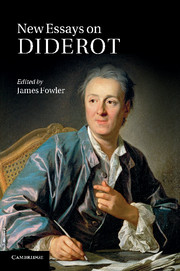Book contents
- Frontmatter
- Contents
- Notes on contributors
- Acknowledgements
- List of abbreviations
- Introduction
- PART I DIDEROT THE PHILOSOPHE
- PART II NOVELS
- 7 Les Bijoux indiscrets: transition or translation?
- 8 Jacques le fataliste et son maître: finding myself in the work of another
- 9 La Religieuse: Diderot's ‘Richardsonian’ novel
- PART III DIALOGUES
- PART IV PLAYS AND DRAMATIC THEORY
- PART V MUSIC, PERFORMANCE, AESTHETICS
- Select bibliography
- Index
7 - Les Bijoux indiscrets: transition or translation?
Published online by Cambridge University Press: 11 April 2011
- Frontmatter
- Contents
- Notes on contributors
- Acknowledgements
- List of abbreviations
- Introduction
- PART I DIDEROT THE PHILOSOPHE
- PART II NOVELS
- 7 Les Bijoux indiscrets: transition or translation?
- 8 Jacques le fataliste et son maître: finding myself in the work of another
- 9 La Religieuse: Diderot's ‘Richardsonian’ novel
- PART III DIALOGUES
- PART IV PLAYS AND DRAMATIC THEORY
- PART V MUSIC, PERFORMANCE, AESTHETICS
- Select bibliography
- Index
Summary
For some considerable time, Diderot's novel Les Bijoux indiscrets (The Indiscreet Jewels) was relegated to a place amongst the minor and even obscene works, in the Enfer of the Bibliotheque Nationale, Paris. Now, however, it is considered to be one of Diderot's major works, and its philosophical importance is widely recognised. The philosophe wrote this, his first novel, in 1747. More than twenty years later, between 1770 and 1775, he added three chapters that enhance the philosophical significance of the work: ‘Le Rêve de Mangogul’ (‘Mangogul's Dream’), ‘Des Voyageurs’ (‘The Explorers’) and ‘De la figure des insulaires et de la toilette des femmes’ (‘On the Islanders’ Appearance and their Women's Style of Dress’). In writing Les Bijoux, Diderot made use for the first time of the form known as the ‘philosophical novel’, a hybrid genre with which he will come to be closely associated.
As Diderot combines philosophy and the (libertine) novel for the first time in his writing career, he produces a formally complex work that deserves to be called seminal. On one level, the bijoux (‘jewels’, or women's genitals) of the title permit a symbolic or allegorical representation of the new (or newly perceived) world which the Enlightenment philosophes will not cease to try to interpret – or rather, in this case, to hear. Taken together, the thirty-one trials of the magic ring given to the sultan Mangogul by the good genie Cucufa constitute a truly encyclopedic world tour, or at least a tour of the ‘feminine’ world of sex and pleasure, a journey subject to various twists and turns, vicissitudes, surprises and discoveries.
- Type
- Chapter
- Information
- New Essays on Diderot , pp. 101 - 112Publisher: Cambridge University PressPrint publication year: 2011

